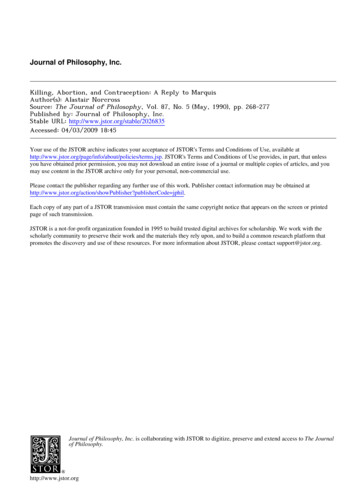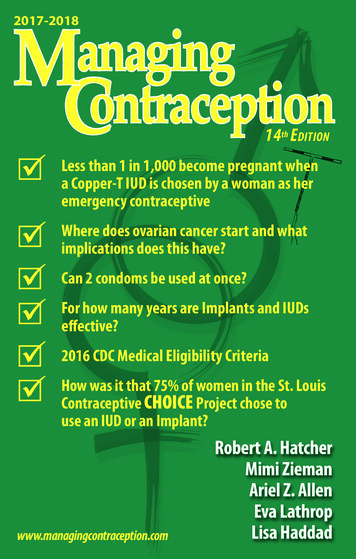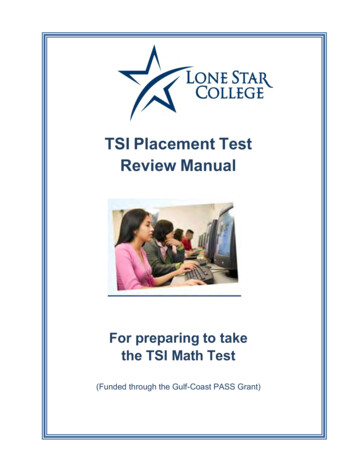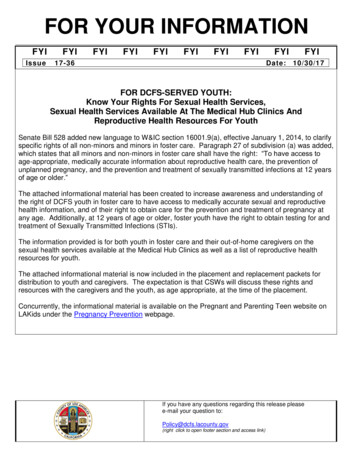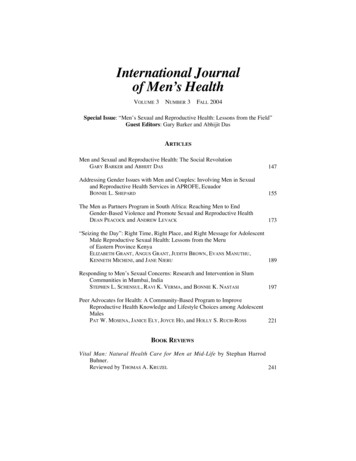
Transcription
HOW I PRACTICE: CONTRACEPTIONCATHERINE TAKACS WITKOP, MD, PHD, MPH April 2022 by the American College of Obstetricians and Gynecologists, 409 12th Street SW, Washington, DC 20024- 2188. All rights reserved. No part of thispublication may be reproduced, stored in a retrieval system, posted on the internet, or transmitted in any form by any means, electronic, mechanical,photocopying, recording, or otherwise, without prior written permission of the publisher.WomensPreventiveHealth.org 1
DISCLAIMER This project was supported by the Health Resources and Services Administration (HRSA) of the U.S.Department of Health and Human Services (HHS) under grant number UHOMC29440, Bright Futuresfor Women’s Health: Standard Practice Guidelines for Well Women Care. This information or contentand conclusions are those of the author and should not be construed as the official position nor policyof, nor should any endorsements be inferred by HRSA, HHS, or the U.S. Government. The contents of this presentation are the sole responsibility of the speaker and do not necessarilyreflect the views, assertions, opinions, or policies of the Uniformed Services University of the HealthSciences (USUHS), the Department of Defense (DoD) or the Departments of the Army, Navy, or AirForce. Mention of trade names, commercial products, or organizations does not imply endorsement bythe U.S. Government. The presenter has no conflicts of interest to declare.WomensPreventiveHealth.org 2
PRESENTERCatherine T. Witkop, MD, MPH, Col (Ret), USAF, MCDr. Catherine Takacs Witkop, MD, MPH, is the Associate Dean for MedicalEducation at the F. Edward Hebert School of Medicine, “America’sMedical School,” Uniformed Services University (USU), Bethesda, MD.Dr. Witkop is Professor of Obstetrics & Gynecology and PreventiveMedicine at USU and is board certified and clinically active in bothspecialties. Dr. Witkop is a Fellow of both the American College ofObstetricians and Gynecologists (ACOG) and the American College ofPreventive Medicine (ACPM). She serves on the Multidisciplinary SteeringCommittee and Dissemination and Implementation Steering Committeefor the Women’s Preventive Services Initiative (WPSI).No conflicts of Interests to DiscloseWomensPreventiveHealth.org 3
CONTRACEPTION In the United States, nearly half of pregnancies are unintended (defined as pregnancy eithermistimes or unwanted). Adverse effects of unintended pregnancies include delayed prenatal care, premature birth, andnegative physical and mental health effects for children; 32-34 and maternal depression, physicalviolence during pregnancy, and others for women 1 in 3 women reported that because of the pandemic, they had to delay or cancel visiting aclinician for SRH care, or had trouble gettingWomen’s Preventive Services Initiative. Contraception. Washington, DC. WomensPreventiveHealth.org 4
WPSI Well-Woman Chart*Women’s’ Preventive Services Initiative: Well-Woman Chart. Available at: art/
WPSI RECOMMENDATION FOR CONTRACEPTIONContraceptive care should include:ScreeningCounselingEducationProvision ofContraceptivesContraceptive care also includes follow-up care (eg, management, evaluation, andchanges, including the removal, continuation, and discontinuation ofcontraceptives).Women’s Preventive Services Initiative; Contraception Recommendation. Washington ations/contraception/WomensPreventiveHealth.org 6
HOW I PRACTICE: CONTRACEPTION Establish a procedure to schedule and carry out virtual and in-person visits, as indicated. Schedule initial telehealth visit to assess patient needs. Contraceptive methods including the pill, the patch, and ring, as well as emergency contraception can allbe ordered for a patient without an in-person visitIn-person visits for contraceptives that require a procedure can serve several purposes including: Ensure the patient selects the best method for them. Optimize the scheduling of the procedure Reduce the length of time of the in-person visit.WomensPreventiveHealth.org 7
HOW I PRACTICE: CODINGCorrect coding can result in more appropriate compensation for services and reduce claim denials. For coding resources,including CPT codes and Medicare and Medicaid guidance, please download the free WPSI Coding Guide. For informationabout coding for digital and telehealth services, visit ACOG’s Practice Management Coding website.WomensPreventiveHealth.org 8
HOW I PRACTICE: SHAREDDECISION MAKINGShared decision making is an approachin which a patient’s preferences andvalues are considered in addition to thescientific evidence about a particularmethod and the decision is made jointlyby the clinician and patient.WomensPreventiveHealth.org 9
DECIDE BE READY An interactive app developed toeducate users on birth controlmethods. It features educationmodules, ‘information quickies’ ontopics like IUDs and breastfeeding,and the capability to contact andrecord questions for ones provider.WomensPreventiveHealth.org 10
USEFUL RESOURCES Bedsider Birth Control Support Network (for patientsand providers): www.bedsider.org Planned Parenthood Telehealth re/getcare-online Contraceptive Care During ive-careduring-covid-19 Decide Be Ready App: can be found using a numberof search terms: “Decide Be Ready”; “birth control”,“decide be ready” etc. It is also available at iTunes andAndroid app stores.WomensPreventiveHealth.org 11
THANK YOU!@TheWPSIWomen’s Preventive Services Initiative (WPSI)
Dr. Witkop is Professor of Obstetrics & Gynecology and Preventive Medicine at USU and is board certified and clinically active in both specialties. Dr. Witkop is a Fellow of both the American College of Obstetricians and Gynecologists (ACOG) and the American College of Preventive Medicine (ACPM). She serves on the Multidisciplinary Steering

